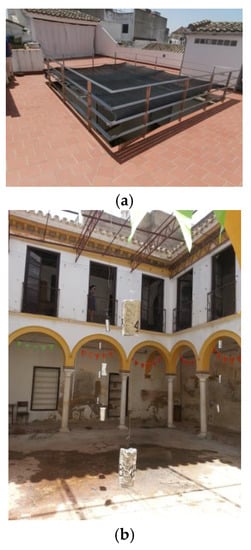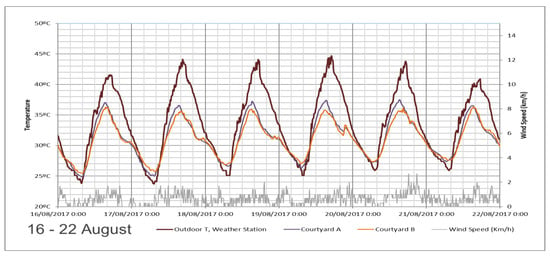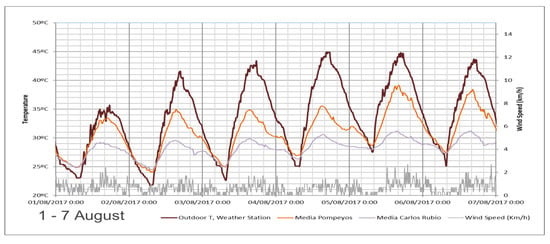Abstract
This study analyzes the thermal performance of courtyards in traditional buildings in the city center of Córdoba (South of Spain), one of them displaying a shading component, to determine the influence of this precise element. The courtyards have been monitored simultaneously during a summer period when temperatures during the day reached over 45 °C. The obtained data was contrasted, and we confirmed that the shading element provided an improvement of the thermal performance of the courtyard which doubled the thermal leap between outdoor and inside the courtyard temperatures when the shading element was installed, in comparison to the courtyard without shade. Therefore, the tempering effect of courtyards can be significantly improved by means of using these simple elements.
1. Introduction
The design of nearly zero energy buildings (NEZB) is one of the main objectives of architecture regarding the predicted future of climatic change and energy shortage [1,2] There are many passive conditioning strategies to enforce in new buildings to achieve this objective energy saving. However, the real challenge is to be able to improve the energy performance of the actual building stock. Among the different passive strategies, the courtyard is an element that is already present in most buildings in certain climates. Being able to understand the thermal performance of the courtyards and the different elements that may affect them is the previous step to design an intervention strategy.
Many factors have been reported to determine the thermal behavior of the courtyards i.e., geometry and orientation, vegetation, water, the albedo of the surfaces (the fraction of incident solar radiation reflected) and elements of shade [3,4]. This very last one could be the easiest and most economical one to be implemented in any existing building, what justifies the interest of this study.
2. Materials and Methods
2.1. Courtyards Description
For our study, two courtyards with different geometries, were monitored during three weeks in the city of Córdoba (Spain, 37°53′00″ N 4°46′00″ O, elevation 106 m a.s.l). Córdoba is characterized by the highest summer severity possible in Spain as per the climate classification established in the Spanish Building Code.
The courtyards analyzed in this paper belong to two traditional patio- houses in the historic city center of Córdoba, World Heritage Site, which is characterized by its density of two to three storey buildings. To define the geometry of the courtyards, the concept of Aspect Ratio is used:
where hmax = maximum height of the courtyard and W = width of the courtyard.
AR = hmax/W
The two courtyards are described as follows:
- Courtyard A: It belongs to a traditional patio-house that has been refurbished. It is 4.3 × 4.0 m and a height of 6.3 m. The coating of the surface is white cement mortar. The courtyard has a maximum AR of 1.84 and a minimum of 1.47. The rooftop of the building is a terrace which allows the installation of a black canvas mesh that provides shadow to the courtyard, filtering the solar radiation that otherwise would affect the surfaces of its the walls (Figure 1a). The vegetation of the courtyard is another element that must be considered when analyzing its performance.
 Figure 1. Images of the courtyards. (a) Canvas cover installed in the courtyard A. (b) Arcade of courtyard B.
Figure 1. Images of the courtyards. (a) Canvas cover installed in the courtyard A. (b) Arcade of courtyard B. - Courtyard B: The building is a classic palace house that has suffered a few transformations through the time. Nowadays, the nearly squared courtyard is surrounded by an arcade in three of its four sides (Figure 1b). Its dimensions are 7.8 × 8.4 m and a height of 6.8 m. This means an AR of 0.81 and 0.87 in each direction.
2.2. Monitoring
The monitoring took place during a three-week period of the hottest months of the year, from 26 July to 22 August of 2017. This period recorded the highest temperatures ever registered in Córdoba, that suffered an important heat wave that year, according to Spanish Meteorological Agency (AEMET).
Air temperature was recorded inside the courtyard using sensors model TESTO 174 T located at three different heights at each wall of the courtyards. In order to avoid overheating due to solar radiation, the sensors were protected with insulating material shields. A total number of twelve sensors were placed in each courtyard. Outdoor temperature and wind velocity were also recorded by means of a meteorological station model PCE-FWS 20 placed in the rooftop of the building.
Courtyard A was monitored with the shading element from 26 July to 7 August, and without the shading component from 8 to 22 August. Courtyard B was monitored in the same unshaded conditions during that whole period. The canvas cover that was installed was black polyethylene of 60–70% UV filter, and around 70 g/m2 density, fixed on top of the railing as shown in Figure 1.a, allowing the wind flows to go out of the courtyard, in order to avoid overheating and thus allowing the loose of accumulated heat during the day.
3. Results
3.1. Unshaded Monitoring
Figure 2 shows the results obtained in six days during the period from 8 to 22 August, when none of the courtyards were shaded. The maximum outer air temperature ranged between 40–45 °C during the day and minimum temperature at night registered 22–25 °C. The figure also shows the recorded temperature in both courtyards during that period. Shading of Courtyard A was removed, creating the most possible similar situation to Courtyard B. Both courtyards displayed a very similar performance this period, with a maximum of 2 °C of difference at peak hours (Courtyard B performing slightly better). The temperature in the courtyards does not go beyond 38 °C. However, at night, there is a slight overheating effect, maintaining the courtyards around 2 °C warmer than the outside.

Figure 2.
Air temperatures and wind speed in courtyards and the outside from 16 to 22 August.
3.2. Shaded Monitoring
Figure 3 shows the results of the monitoring taking place from 1 to 7 August, a selected period when the shading element was installed in Courtyard A. In this period, outdoor temperatures ranged in the same values as the previously described, with a maximum of 45 °C and a minimum of 22 °C.

Figure 3.
Air Temperatures and Wind Speed in courtyards and the outside from August 1st to 7th.
In courtyard A, protected from direct solar radiation by the canvas cover, temperatures never went beyond 31 °C. The night overheating effect still occurred. The indoor-outdoor temperature difference in this period reached 15 °C in the shaded courtyard, the 5 August. Courtyard B presents similar monitoring results to those recorded in the previously analyzed period.
4. Discussion
The comparison of the results provided by the two courtyards highlights the significant benefits of a simple shading element used to improve the performance of the courtyard in this climate. The mean temperature difference in both courtyards in the days from 26 July to 7 August has been calculated and represented as a type day in Figure 4.

Figure 4.
Mean Outdoor- Indoor temperature difference at each hour of the day.
Unshaded means of both courtyards are rather similar, displaying a slight difference between 11:00 and 16:00 h of 1–2 °C. However, contrasting Courtyard A lines, shaded and unshaded, it can be seen that the shading element produced a mean temperature difference of 12 °C between the courtyard and the outside in the hottest hour of the day, while in the unshaded courtyard this difference was only 6 °C on average. This allows us to emphasize the great improvement that a simple canvas element produces in the thermal performance of the courtyard.
5. Conclusions
The results suggest that the already confirmed thermal benefits of courtyards in hot arid climates could be easily improved by using shading elements. The higher the exterior temperature was, the higher of a temperature drop was measured in the interior of the shaded courtyard. The relevance of this fact is the possibility of adopting this strategy in existing buildings, improving their energy efficiency and preparing them for the predicted global warming because of the climate change.
Author Contributions
C.G.-M. and J.M.R.-F. conceived and designed the experiments; C.R.-G. and J.M.R.-F. performed the experiments; V.P.L.-C. and C.G.-M. analyzed the data and wrote the paper.
Acknowledgments
The authors wish to acknowledge the IUACC “Instituto Universitario de Arquitectura y Ciencias de la Construcción” for the necessary support to develop this research. This work has been funded by the National Government of Spain Research Project MTM2015-64577-C2-2-R.
Conflicts of Interest
The authors declare no conflict of interest. The founding sponsors had no role in the design of the study; in the collection, analyses, or interpretation of data; in the writing of the manuscript, and in the decision to publish the results.
References
- Stocker, T.F.; Qin, D.; Plattner, G.K.; Tignor, M.M.B.; Allen, S.K.; Boschung, J.; Nauels, A.; Xia, Y.; Bex, V.; Midgley, P.M. Working Group I Contribution to the Fifth Assessment Report of the Intergovernmental Panel on Climate Change. In Climate Change 2013—The Physical Science Basis; Cambridge University Press: Cambridge, UK, 2013; pp. 33–115. [Google Scholar] [CrossRef]
- European Commission. Directive 2010/31/EU of 19 May 2010 on the Energy Performance of Buildings (Recast). Off. J. Eur. Union 2010, 18, 13–35. [Google Scholar] [CrossRef]
- Ghaffarianhoseini, A.; Berardi, U.; Ghaffarianhoseini, A. Thermal performance characteristics of unshaded courtyards in hot and humid climates. Build Environ. 2015, 87, 154–168. [Google Scholar] [CrossRef]
- Abdulkareem, H.A. Thermal Comfort through the Microclimates of the Courtyard. A Critical Review of the Middle-eastern Courtyard House as a Climatic Response. Procedia Soc Behav Sci. 2016, 216, 662–674. [Google Scholar] [CrossRef]
Publisher’s Note: MDPI stays neutral with regard to jurisdictional claims in published maps and institutional affiliations. |
© 2018 by the authors. Licensee MDPI, Basel, Switzerland. This article is an open access article distributed under the terms and conditions of the Creative Commons Attribution (CC BY) license (https://creativecommons.org/licenses/by/4.0/).